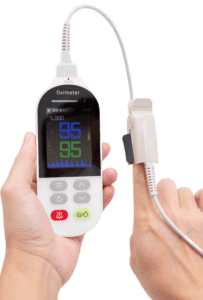Introduction:
Handheld pulse oximeters have revolutionized the world of healthcare, providing a remarkable way to monitor vital signs with ease and convenience. In this article, we will delve into the fascinating realm of handheld pulse oximeters, exploring their functionality, working principles, and their significance in modern medical practices. Join us on this captivating journey as we unravel the wonders of these remarkable devices.
Section 1: The Marvel of Handheld Pulse Oximeters
Handheld pulse oximeters are compact devices that offer a portable solution for monitoring blood oxygen saturation levels. These nifty gadgets provide healthcare professionals and individuals alike with valuable insights into respiratory health. Their convenience and non-invasive nature have made them indispensable in various medical settings, from hospitals to home care.

Section 2: Understanding the Inner Workings
At the heart of a handheld pulse oximeter lies a sophisticated blend of technology and innovation. These devices consist of several crucial components working seamlessly together:
- Light Emission: The pulse oximeter emits light waves, typically red and infrared, into the patient’s body. These specific wavelengths are carefully chosen as they are absorbed by oxygenated and deoxygenated hemoglobin.
- Light Absorption: As the emitted light waves penetrate the patient’s skin and tissues, they encounter the blood vessels. Here, oxygenated hemoglobin absorbs more infrared light, while deoxygenated hemoglobin absorbs more red light.
- Photodetection: Within the pulse oximeter, a highly sensitive photodetector captures the intensity of the transmitted light waves after they pass through the patient’s blood vessels.
- Signal Analysis: A remarkable microprocessor within the device comes into play, analyzing the received light signals. By calculating the ratio of absorbed red and infrared light, the microprocessor determines the oxygen saturation level in the patient’s blood.
- Display of Vital Insights: The results, including the oxygen saturation level (SpO2) and often the pulse rate, are promptly displayed on a clear screen. This real-time information empowers healthcare professionals and individuals to make informed decisions about patient care and overall well-being.
Section 3: The Significance of Handheld Pulse Oximeters
The emergence of handheld pulse oximeters has had a profound impact on healthcare practices worldwide. Their portable nature and ease of use have revolutionized patient monitoring, allowing for quick and efficient assessments. Healthcare professionals can closely track oxygen saturation levels, aiding in the diagnosis and management of respiratory conditions.
Section 4: The Role of Oximeter Factories and Manufacturers
Behind the scenes, dedicated oximeter factories and manufacturers play a vital role in ensuring the production of high-quality devices. These facilities employ skilled engineers, researchers, and technicians who work diligently to improve the accuracy, reliability, and user-friendliness of hand-held pulse oximeters. Their commitment to innovation and quality ensures that healthcare providers and individuals have access to cutting-edge devices that enhance patient care.
Conclusion:
Handheld pulse oximeters have transformed the way healthcare professionals monitor blood oxygen saturation levels. Through their remarkable functionality and seamless workings, these devices have become indispensable in healthcare settings worldwide. With the tireless efforts of oximeter factories and manufacturers, the future holds exciting possibilities for further advancements in pulse oximetry technology. Embrace the marvels of hand-held pulse oximeters and witness the profound impact they continue to make in the realm of healthcare.

